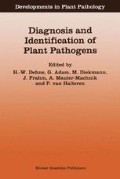Abstract
A bioassay with tomato as bait plants was compared with detection by ELISA using a dilution series of spore balls in uncontaminated soil. The relationship between A405 values and spore ball concentration/g soil appeared to be linear and raw antiserum detected down to 100 spore balls/g soil. Discrimination of spore ball levels improved with concentrations above 2000/g soil, whereas the bioassay showed better discrimination of spore ball levels below 2000/g soil. When a range of soils from Swiss potato fields with known bioassay scores were tested by ELISA, raw serum discriminated most of the soils with higher scores (≥ 3) from those with lower scores, but not between uncontaminated and infested soils with lower scores (<3). Of the three soils with scores higher than 3, the two where high tuber disease indexes were obtained also gave highest A405 values. The ability of the antiserum to discriminate infested field soils from uncontaminated ones was much improved by using the γ-globulin fraction, or serum which had been cross-absorbed with uncontaminated soil. The results are discussed and advantages and disadvantages of both detection methods compared.
Access this chapter
Tax calculation will be finalised at checkout
Purchases are for personal use only
Preview
Unable to display preview. Download preview PDF.
References
Merz, U. (1989) Infectivity, inoculum density and germination of Spongospora subterránea resting spores: a solution-culture test system, EPPO Bulletin 19, pp. 585–592.
Merz, U. (1993) Epidemiological aspects of powdery scab of potatoes caused by Spongospora subterránea, Proceedings of the Second Symposium of the International Working Group on Plant Viruses with Fungal Vectors, 1993, McGill University, Montreal, Canada, pp. 103–106.
Wale, S. J.; Burgess, P. J., and Burnett, F. (1993) Bioassay for Spongospora subterráneo detection in soil and its potential use in predicting powdery scab in the field, Proceedings of 6th International Congress of Plant Pathology, Montreal, Canada, Abstract 16.4.2, pp. 281.
Author information
Authors and Affiliations
Editor information
Editors and Affiliations
Rights and permissions
Copyright information
© 1997 Kluwer Academic Publishers
About this chapter
Cite this chapter
Merz, U., Walsh, J.A. (1997). Serological Detection of Spongospora Subterranea F.SP. Subterranea in Soil. In: Dehne, HW., Adam, G., Diekmann, M., Frahm, J., Mauler-Machnik, A., van Halteren, P. (eds) Diagnosis and Identification of Plant Pathogens. Developments in Plant Pathology, vol 11. Springer, Dordrecht. https://doi.org/10.1007/978-94-009-0043-1_27
Download citation
DOI: https://doi.org/10.1007/978-94-009-0043-1_27
Publisher Name: Springer, Dordrecht
Print ISBN: 978-94-010-6508-5
Online ISBN: 978-94-009-0043-1
eBook Packages: Springer Book Archive

